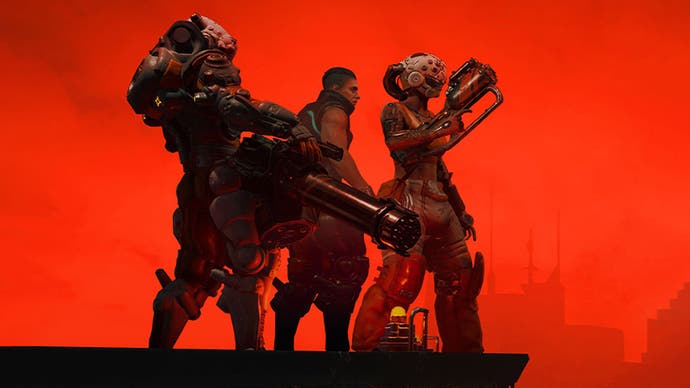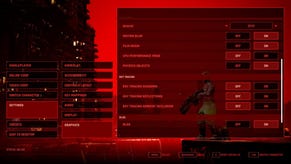The Ascent hits PlayStation 5 - and it's as beautiful as ever
Last-gen and current-gen versions tested.
What is the most visually impressive indie game you've ever seen? From our perspective, The Ascent - released last summer for PC and Xbox - is a strong candidate. This Unreal Engine 4-based isometric action game features dense environmental geometry, great lighting, and high quality effects work. It's easily mistaken for a big-budget title but was in fact primarily made by Neon Giant, a small Swedish studio with just 12 core developers. Previously an Xbox console exclusive, The Ascent is now available for current-gen and last-gen PlayStation consoles - and we highly recommend it.
Whether you're gaming on PS4 or PS5, The Ascent retains its signature visual appeal - it's a beautiful title that combines extremely detailed environmental geometry with stunning pyrotechnics. As action breaks out The Ascent becomes an electrifying visual showcase, bathed in explosions and bullet trails. The interplay between the environment and the action is a key highlight here: stray bullets and explosions chip at barriers and take chunks out of concrete slabs. Despite massive levels packed with dense environmental meshes, everything seems to fit together surprisingly well, without any geometric or lighting discontinuities. Even the game's narrative sequences, which zoom in to close range, don't highlight many shortcomings.
So how do the ports to the various PlayStation platforms stack up? While we didn't see it in our measurements, dynamic resolution scaling can't be rolled out - but unsurprisingly, PS5 leads the pack with a dense 1800p resolution, targeting 60fps, while PS4 Pro drops back to 1440p30. The base PS4 seemingly locks to 900p - a quarter of PS5's resolution at half the target performance level. Image quality isn't bad: UE4's TAA does a good job of cleaning up the image, so all consoles look stable and smooth in motion - the weaker machines just aren't as sharp.
The improvement found on PS5 isn't just limited to pixels and frame-rate: ground detail is pared back on PS4, environmental draw distance is reined in, while real-time shadow maps have less detail, while fewer objects cast shadows. Bloom lighting takes on a different appearance, and generally looks weaker and less precise. The depth of field effect in cutscenes runs at a reduced quality, without a strong bokeh effect. Finally, the number of background NPCs in the environment is reduced. PS4 Pro occupies a bit of a middle ground here - depth of field, bloom, and NPC density appear similar to PS5, while other settings look similar to PS4.
Looking towards the current-gen PS5 vs Series X shoot-out, once again, there's not much to tell them apart - they seemingly render with identical quality settings with similar overall image clarity (to confirm: Series X measurements came in at the same 1800p as PS5). Minor run-to-run differences in object and NPC placement are apparent, but there are no consistent visual changes between the two platforms.
Performance issues beset the Xbox versions of The Ascent - and months on from initial release, our two basic issues with the game haven't changed. Every so often when moving around the game world, the character and camera angle would jump forward, with a few frames of movement condensed into a single frame. It felt sort of like the game was suffering a brief performance hitch but in reality the frame-rate wasn't affected whatsoever - your character would just slightly skip between frames.
Performance would also dip in a more conventional sense. Frame-rate hitches lasting a few frames were common on Series X and S, and heavy combat would occasionally see performance slip into the 50-60fps range for short periods. Xbox One and One X had the same issues but were exacerbated by the weaker hardware, with more impactful and frequent hitches that often extended beyond 100ms.
The good news is that the PS5 release is mostly in quite good shape. Both of these performance issues remain in place but don't impact on the experience too much. Actual frame-rate dips are relatively rare, mostly isolated to heavy combat, with an occasional mini-stutter or two during traversal. The movement skips are still an annoyance on PS5 but I mostly got used to them over time, as they don't affect frame delivery and don't tend to surface during combat very much.
In a head-to-head with Series X, trouble areas on Microsoft's console trade off with problematic areas on PS5. Both can exhibit minor performance drops in different areas, but across the run of play, the overall experience is virtually identical - both mostly hitting the 60fps target, with the differences we do see changing on a run-by-run basis. PS4 and PS4 Pro are cut back to a 30fps target, dropping frames in combat, as you might expect, but typically it's just small amount of stutter per encounter. Some of the larger areas with lots of AI can push the systems harder, particularly the PS4, although this isn't terribly common.
Unfortunately, the PS4 systems are plagued by streaming stutter - dramatic frame-time stutters that are much worse than on PS5 and Series X. Asset streaming seems to be a particular difficulty for the last-gen consoles' weaker CPUs, which just can't seem to keep up as you travel The Ascent's large maps. It's serviceable enough on the PS4 consoles but the experience on current-gen hardware is much improved. In between the stutters, the PS4 builds run fine, with a well-implemented 30fps cap without frame-pacing issues.
The initial release of The Ascent was infamous for long load times on Xbox One consoles, requiring a Series machine for an adequate experience. Testing the most recent patch, things haven't changed much. Averaged across three runs, still takes Xbox One X takes 177 seconds in the initial load. Xbox One S, bizarrely, takes 151 seconds - 17 percent faster than One X. PlayStation is undeniably faster, with the base PS4 loading in 'just' 71 seconds - half the time of the vanilla Xbox One. PS4 Pro takes that down to just 52 seconds. PS5 is faster, but not to a dramatic degree, requiring 43 seconds of loading in total. Series X comes in a touch faster, with a 38 second initial load. It's nothing objectionable of course but it's typically a longer wait than most other current-gen titles.
In summary, the PlayStation versions of The Ascent offer a great way to open up the game to more players, the only slight niggle being that existing issues in the Xbox versions remain unaddressed. However, those issues have little impact on the quality of the game and regardless of platform, The Ascent is an excellent release that shouldn't be missed.










